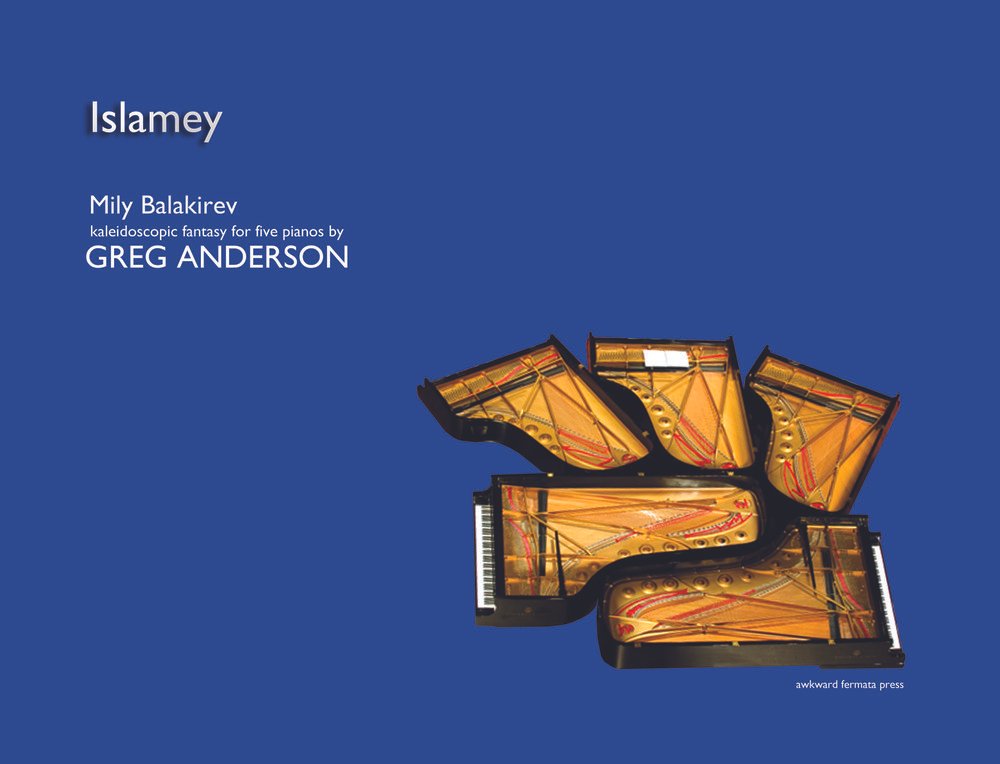Details
Stars & Stripes: Fireworks for 8 pianos, 32 hands by Greg Anderson, based on “The Stars & Stripes Forever March” by John Philip Sousa / Full score plus eight piano duet parts / Difficulty: Advanced / Duration: 10 minutes / Pages: 247 / Copyright: 2024 / Work number: 114
Program notes
Commissioned by the Aspen Music Festival in 2024, "Stars & Stripes: Fireworks for 8 Pianos, 32 Hands" transforms Sousa’s famous march into a ten-minute tone poem of light and color.
Writing for sixteen pianists on eight pianos presented compositional puzzles at every turn, but it also ignited fresh ideas. Rather than struggle against the pianos’ percussive attack, the piece unleashes all 160 fingers and 704 keys in glittering pointillistic textures. Clouds of tremolandi, swirling storms of chromaticisms, and musical rainbows bathe the familiar melodies in new light, culminating in the promised fireworks at the work’s climax.
Part tribute, part question mark, “Stars & Stripes” reexamines Sousa’s patriotic anthem from unexpected perspectives. The score opens in an iridescent mist that depicts the morphing hues at daybreak. After a series of call-and-response gestures, solos, and cadenzas, the sixteen pianists gather speed “like a steam locomotive” and the march finally breaks through—only to dissolve again. At the work’s core is a depiction of a lone “flag blowing in the wind” (evoking the flag imagery in Sousa’s lyrics), portrayed by an uncertain melody wavering between major and minor amidst gusts of arpeggios circling the pianos.
The piece’s last act is a series of graduated climaxes—some feints, some full-force. Pianists divide into opposing teams before reconverging, detonating fractured march fragments and dazzling firework bouquets. At last, with all dampers lifted, the sixteen players repeat thick chords at full volume, amassing a tidal wave of sound and sympathetic vibrations.
—Greg Anderson
Performance notes
The sheet music for the eight piano parts features a cue staff as well as stacked primo and secondo parts (versus individual or side-by-side parts), allowing the two pianists seated at each piano to coordinate pedaling, choreography, and timing. The pagination allows for performance using both printed scores and tablets. For printed scores: even pages on the left and odd pages on the right.
↓ = call to attention: change in patterns, unusual (but correct) notes, etc.
↑ = move hands: your partner needs the space
A conductor is recommended to assist with timing and balance. If performing without a conductor, the pianist playing the notes indicated in the cue staff should take the lead; the ensemble can select a pianist to lead during full tutti sections.
Much of the piece features unique effects created by the 16 piano parts. Overlapping tremolandi, scales, and arpeggios accumulate to create the illusion of clouds, fireworks, and rainbows, much like an impressionist painting. In passages featuring tuplets and tremolandi, meticulous rhythmic precision is unnecessary; rather, each pianist should aspire to create beautiful, fluid shapes that align with prominent melodies (notated in the cue staff), barlines, or anchor points.
Careful balancing of dynamics is essential. Throughout, the 16 pianists may need to play softer than customary or even expected. Listen for the music notated in the cue staff; if you can’t hear it, play quieter. Passages marked “Solo,” on the other hand, should be clearly audible; if they aren’t, play them louder. Often these “solos” are merely a few notes, but they are important, nonetheless. The speed of the tremolandi can be slower in softer passages and faster when louder.
Partnered pairs (primo and secondo) should rehearse prior to the first full rehearsal to coordinate playful and essential choreography. Unusual fingerings and hand distributions are often intended to aid four-hand playability, as are a few choreographic suggestions such as “under Primo” or “over Secondo.” Unless noted, secondo pianists should operate the pedals. The notated pedal markings generally highlight atypical pedal requests; elsewhere secondi pianists should pedal intuitively.
The pianos with the best bass registers (likely the largest pianos) should be reserved for Pianos 1 & 8, followed by Pianos 2 & 7, and Pianos 3 & 6. Pianos 4 & 5 should have the pianos with the weakest bass registers.
The work was composed with the piano layout pictured here in mind. The layout augments the spatial effects featured in the work, and it offers pianists the best vantage points to assess balance and make eye contact. Other layouts are welcomed, though aim to keep Pianos 1-4 on stage right and Pianos 5-8 on stage left.
—Greg Anderson
Blog entry
Aspen Music Festival commission + conducting debut





















